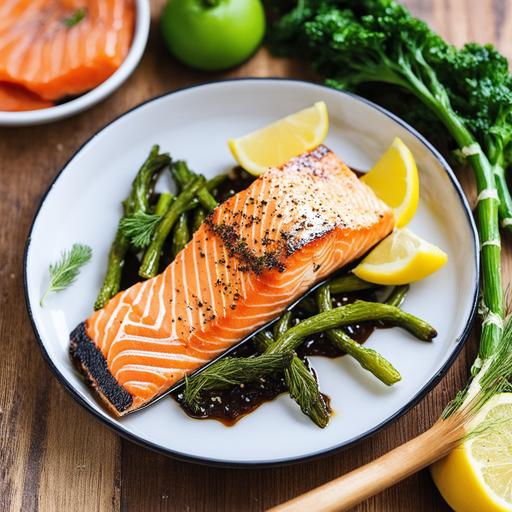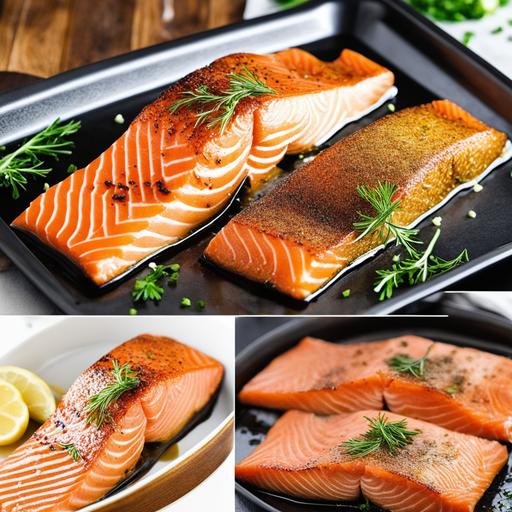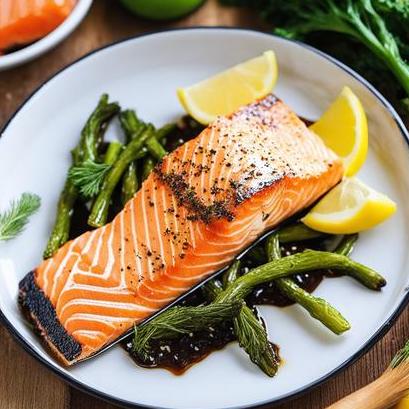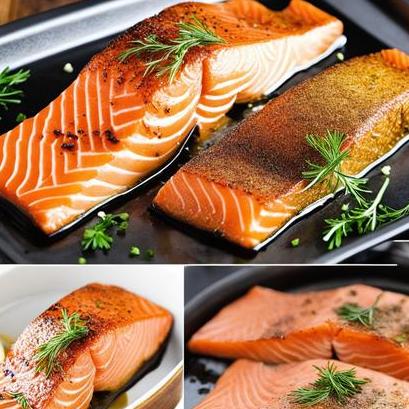
Salmon With Skin Oven Recipe: The Ultimate Guide
Salmon with skin is a delicious and healthy dish that is easy to prepare and can be cooked to perfection in the oven. In this comprehensive guide, we will cover everything you need to know about selecting, cleaning, preparing, and cooking salmon with skin in the oven. We’ll also share some tips and variations to help you make the most of this tasty fish.
Why Choose Salmon with Skin?
Salmon is a nutritious fish that is high in protein, omega-3 fatty acids, vitamin D, and other important nutrients. Choosing salmon with skin intact offers an additional layer of flavor and texture that enhances the overall eating experience. The skin helps to keep the fish moist as it cooks and provides a crispy exterior that is both delicious and visually appealing.
Selection and Cleaning
When selecting salmon, look for fresh fish with shiny and firm skin that is free from any discoloration or blemishes. The flesh should be bright and free from any dark spots or discoloration. If you’re not sure how fresh the fish is, you can ask your fishmonger for advice.
To clean salmon with skin, rinse the fish under cold running water, paying special attention to the cavity and skin side of the fish. Using a clean and sharp knife, remove any remaining scales by scraping from the tail to the head. Next, pat the fish dry with a paper towel to remove any excess moisture.
Preparation and Tips

Before cooking your salmon with skin, it’s important to let it come to room temperature. This will help the fish cook more evenly and prevent it from drying out.
To prepare your salmon with skin, you can season it with your favorite herbs and spices. Lemon, garlic, and parsley are classic flavor combinations that work well with salmon. You can also add some olive oil, salt, and pepper for a simple and flavorful seasoning.
When baking salmon with skin in the oven, it’s best to place the fish skin side down on a baking sheet or in a baking dish. This will help the skin get crispy and add an extra layer of texture to the dish.
Doneness Checks

To ensure that your salmon is cooked to your desired level of doneness, you can use a meat thermometer to check the internal temperature. The USDA recommends cooking fish to an internal temperature of 145°F or until the flesh is opaque and easily flakes apart.
If you don’t have a meat thermometer, you can also check the fish for doneness by pressing gently on the flesh with a fork. The fish should be firm and flake easily when it’s cooked through.
Recipe

Here’s a simple and delicious salmon with skin oven recipe that you can try at home:
Ingredients
-
2 salmon fillets with skin
-
2 tablespoons olive oil
-
Salt and pepper to taste
-
1 lemon, sliced
-
Fresh herbs (optional)
Instructions
-
Preheat the oven to 400°F.
-
Season the salmon fillets with salt and pepper on both sides.
-
Heat a large skillet over medium-high heat and add olive oil.
-
Place the salmon fillets skin side down in the skillet and cook for 3-4 minutes, until the skin is crispy.
-
Transfer the salmon fillets to a baking tray and top with lemon slices and fresh herbs (if using).
-
Bake in the oven for 8-12 minutes, until the salmon is cooked to your desired level of doneness.
-
Serve the salmon immediately, garnished with additional lemon slices and fresh herbs.
Variations

Here are some variations on the basic salmon with skin oven recipe that you can try:
-
Asian-inspired: Season the salmon with soy sauce, ginger, and sesame oil. Top with scallions and cilantro before baking.
-
Mediterranean: Season the salmon with garlic, oregano, and lemon. Top with cherry tomatoes, olives, and feta cheese before baking.
-
Tex-Mex: Season the salmon with chili powder, cumin, and lime juice. Top with avocado, corn, and black beans before baking.
Overcooking and Undercooking
Overcooking salmon with skin in the oven can cause it to become dry and tough. Undercooking salmon can result in raw or undercooked flesh, which can be unsafe to eat.
To prevent overcooking or undercooking, it’s important to monitor the cooking time and temperature closely. You can use a meat thermometer to check the internal temperature of the fish, or you can use the fork test to check for doneness.
Conclusion
Salmon with skin is a healthy and delicious dish that can be easily prepared in the oven. By following these tips and using the recipe and variations provided, you can make a mouthwatering meal that your family and friends will love. Remember to select fresh salmon, clean it thoroughly, season it to your liking, and monitor the cooking time carefully to achieve the perfect level of doneness. Enjoy!
Sources
FAQS On Salmon With Skin Oven Recipe
What Is The Best Way To Prepare Salmon With The Skin In The Oven?
To prepare salmon with the skin in the oven, start by preheating your oven to 400°F (200°C). Lightly oil a baking sheet or line it with parchment paper to prevent the salmon from sticking. Season the salmon fillets with salt, pepper, and any desired herbs or spices. Place the salmon fillets, skin-side down, on the baking sheet. Bake for about 12-15 minutes, depending on the thickness of the fillets, until the skin is crispy and the flesh is cooked through. Serve immediately.
Should I Remove The Skin Before Cooking Salmon In The Oven?
You do not need to remove the skin before cooking salmon in the oven. In fact, leaving the skin on helps protect the delicate flesh of the fish from drying out. Additionally, the skin contains healthy fats that impart flavor and moisture to the salmon. When cooked properly, the skin becomes crisp and adds a delightful texture to the dish.
How Can I Ensure That The Salmon Skin Turns Crispy When Baked?
To achieve a crispy salmon skin when baked, make sure the oven temperature is high enough. Preheating the oven to 400°F (200°C) or hotter allows the skin to crisp up while the salmon cooks. Also, remember to place the salmon fillets skin-side down on a baking sheet or dish without crowding them too closely together. This ensures that the heat circulates evenly around each fillet, leading to a crispy texture.
Can I Season The Salmon Skin Before Baking?
Absolutely! Seasoning the salmon skin before baking adds extra flavor to the dish. Prior to placing the salmon fillets on the baking sheet, you can season the skin with salt, pepper, and any desired herbs or spices. Popular options include garlic powder, paprika, dried dill, or lemon zest. The skin will absorb these flavors while cooking, enhancing the overall taste of the salmon.
How Can I Prevent The Salmon Skin From Sticking To The Baking Sheet?
To prevent the salmon skin from sticking to the baking sheet, there are a few precautions you can take. First, make sure to lightly oil the baking sheet or line it with parchment paper. This creates a non-stick surface for the skin. Secondly, avoid moving or flipping the salmon fillets while baking. This minimizes the chance of the skin getting stuck to the baking sheet. Lastly, if you’re using a stainless steel baking sheet, you can place the salmon on a wire rack set inside the baking sheet. This allows air to circulate around the fillets, preventing the skin from sticking.


